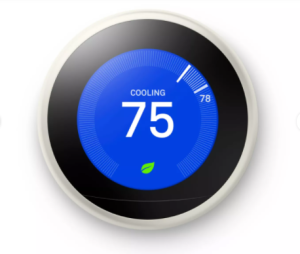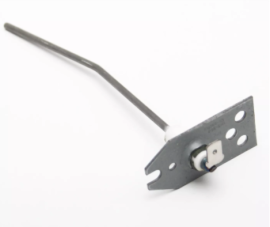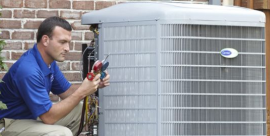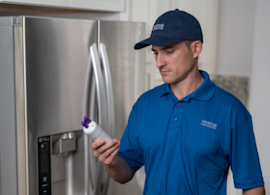- Kenmore refrigerator water filters
- Whirlpool refrigerator water filters
- Samsung refrigerator water filters
- GE refrigerator water filters
- LG refrigerator water filters
- Frigidaire refrigerator water filters
- KitchenAid refrigerator water filters
- Maytag refrigerator water filters
- Kenmore Elite refrigerator water filters
- Estate refrigerator water filters
- GE Profile refrigerator water filters
- Amana refrigerator water filters
- Bosch refrigerator water filters
- Dacor refrigerator water filters
- Electrolux refrigerator water filters
What are the advantages of installing a Nest thermostat on your HVAC system?


The Google Nest thermostat offers nearly countless advantages over a mechanical, non-programmable HVAC thermostat. When connected to Wi-Fi internet access in your home, you’ll be able to remotely monitor and control your HVAC system using the Nest app on your smartphone.
Read on to find out more about key advantages of installing a Google Nest thermostat.
Easy installation
If you’ve been hesitating to replace your current HVAC thermostat because you think a Google Nest thermostat is hard to install, check out this Nest installation video. You can also read the written installation guide to see how to install the Nest thermostat. Installing the Google Nest thermostat is fairly easy and straightforward for most homeowners.
If you are confident that you can install the Nest thermostat yourself after watching the video and/or reading the installation guide, order a new Nest thermostat to upgrade the control on your HVAC system.
Remote monitoring and control
Perhaps the biggest advantage of the Nest thermostat is remote monitoring and control. You won’t have to climb out of bed and walk to the thermostat to check or change its temperature setting. You can monitor and control the Nest thermostat using your smartphone and other connected control devices such as Alexa®.
Using your smartphone, you can set and change thermostat schedules to save energy and money on your electric bill. Also, you can monitor daily and weekly energy usage with your smartphone. See when your HVAC system ran each day in the History mode. Check the total run time for your system each day in the weekly view. Keeping track of your HVAC energy use can help you limit energy bills.
Energy-saving features
In addition to providing you with the ability to schedule and monitor thermostat settings, the Nest thermostat can save you money on energy bills by automatically switching to Eco Temperatures when it senses that nobody is home. Select Eco Temperatures that save you money without harming plants or making your pets uncomfortable. In winter, you’ll need to select an Eco Temperature high enough to prevent pipes from freezing. Select Eco Temperature settings that are close enough to normal thermostat settings so your HVAC system can heat or cool your home to a comfortable temperature shortly after you arrive home.
A Nest Learning thermostat automatically builds a thermostat setting schedule each time you walk in front of the device or manually change the temperature setting. It continuously adjusts the automatic schedule based on constant behavioral input. Using the automatic schedule can help you save money while optimizing you climate comfort.
A Google Nest thermostat allows you to take advantage of additional features such as time-of-use (TOU) and/or demand charge pricing that may be offered by the electric service provider in your area. Check with your local energy provider regarding these types of savings.
With easy installation, smart controls and the potential for steep energy savings, the Nest thermostat is a must-have for your home. The energy savings you enjoy when using a Nest thermostat can quickly add up and the thermostat will pay for itself over time.
Most common symptoms to help you fix your heating & cooling combined units
Choose a symptom to see related heating and air conditioning system repairs.
Thermostat problem, clogged air filter, burner failure…
Dirty air filter, clogged condenser coils, low refrigerant charge, faulty compressor…
Thermostat problems, bad compressor/condenser fan capacitor, lack of refrigerant, failed compressor…
Dirty flame sensor, failed flame sensor, damaged burner, bad high limit switch…
Main causes: errant thermostat settings, lack of electrical power, clogged drain line, wiring failure, control failure.…
Main causes: Errant thermostat settings, lack of power, bad interlock switches, lack of exhaust ventilation, wiring fail…
Most common repair guides to help fix your heating & cooling combined units
These step-by-step repair guides will help you safely fix what’s broken on your HVAC system.

How to unclog the air conditioner drain line
The condensate drain line for your central air conditioner can clog with mold and mildew. Water will back up and start d…
Repair difficulty
Time required
15 minutes or less

How to replace the furnace flame sensor
The flame sensor detects when furnace burner flames are lit. You may need to replace the flame sensor if flames only sta…
Repair difficulty
Time required
15 minutes or less

How to replace a heating and air conditioning system thermostat
The control thermostat for your HVAC system can stop working. This repair guide shows how to replace it.…
Repair difficulty
Time required
30 minutes or less
Effective articles & videos to help repair your heating & cooling combined units
Use the advice and tips in these articles and videos to get the most out of your HVAC system.

Learn how to maintain your central air conditioner to keep it running smoothly all summer long.…

Learn about all the convenient features on our Sears PartsDirect website that make your parts purchases easier.…

Get answers to frequently asked questions about Sears and Sears PartsDirect.…